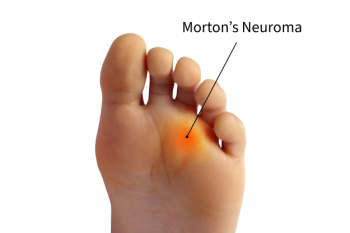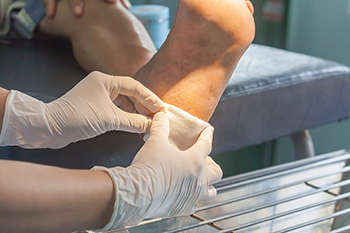
Morton's neuroma is a painful condition affecting the ball of the foot, typically between the third and fourth toes. It occurs when the tissue surrounding one of the nerves leading to the toes thickens, causing sharp, burning pain, numbness, or a sensation of having a pebble in the shoe. Relief remedies for Morton's neuroma include wearing shoes with a wide toe box to reduce pressure on the affected area. Custom orthotic inserts can provide additional support and alleviate pain. Specific stretches and exercises to strengthen the foot muscles can be beneficial in providing relief. In more severe cases, corticosteroid injections or surgery may be necessary. If you have pain in this part of your foot, it is suggested that you confer with a podiatrist who can guide you toward the treatment that is best for you.
Morton’s neuroma is a very uncomfortable condition to live with. If you think you have Morton’s neuroma, contact Brian Shwer, DPM of Southaven Foot Clinic. Our doctor will attend to all of your foot care needs and answer any of your related questions.
Morton’s Neuroma
Morton's neuroma is a painful foot condition that commonly affects the areas between the second and third or third and fourth toe, although other areas of the foot are also susceptible. Morton’s neuroma is caused by an inflamed nerve in the foot that is being squeezed and aggravated by surrounding bones.
What Increases the Chances of Having Morton’s Neuroma?
Morton’s neuroma is a very treatable condition. Orthotics and shoe inserts can often be used to alleviate the pain on the forefront of the feet. In more severe cases, corticosteroids can also be prescribed. In order to figure out the best treatment for your neuroma, it’s recommended to seek the care of a podiatrist who can diagnose your condition and provide different treatment options.
If you have any questions, please feel free to contact our office located in Southaven, MS . We offer the newest diagnostic and treatment technologies for all your foot care needs.

Infected foot wounds often arise from cuts, scrapes, or punctures that become contaminated with bacteria. Common causes include stepping on a sharp object, improper wound care, and existing medical conditions like diabetes that impair healing. Symptoms of an infected foot wound can vary but typically include increased pain, redness, and swelling around the wound site. The area may feel warm to the touch, and pus or other drainage may be present. More severe infections can lead to fever, chills, and swollen lymph nodes. It is essential to recognize these signs early and seek medical attention promptly to prevent the infection from spreading. Proper wound care, including cleaning, applying antiseptics, and covering with sterile dressings, plays a critical role in combating infections and promoting healing. If you have a wound on your foot, it is strongly suggested that you are under the care of a podiatrist who can effectively treat various types of foot wounds.
Wound care is an important part in dealing with diabetes. If you have diabetes and a foot wound or would like more information about wound care for diabetics, consult with Brian Shwer, DPM from Southaven Foot Clinic. Our doctor will assess your condition and provide you with quality foot and ankle treatment.
What Is Wound Care?
Wound care is the practice of taking proper care of a wound. This can range from the smallest to the largest of wounds. While everyone can benefit from proper wound care, it is much more important for diabetics. Diabetics often suffer from poor blood circulation which causes wounds to heal much slower than they would in a non-diabetic.
What Is the Importance of Wound Care?
While it may not seem apparent with small ulcers on the foot, for diabetics, any size ulcer can become infected. Diabetics often also suffer from neuropathy, or nerve loss. This means they might not even feel when they have an ulcer on their foot. If the wound becomes severely infected, amputation may be necessary. Therefore, it is of the upmost importance to properly care for any and all foot wounds.
How to Care for Wounds
The best way to care for foot wounds is to prevent them. For diabetics, this means daily inspections of the feet for any signs of abnormalities or ulcers. It is also recommended to see a podiatrist several times a year for a foot inspection. If you do have an ulcer, run the wound under water to clear dirt from the wound; then apply antibiotic ointment to the wound and cover with a bandage. Bandages should be changed daily and keeping pressure off the wound is smart. It is advised to see a podiatrist, who can keep an eye on it.
If you have any questions, please feel free to contact our office located in Southaven, MS . We offer the newest diagnostic and treatment technologies for all your foot care needs.

Pain in the top of the foot can be a troubling and uncomfortable experience that affects mobility and impedes daily activities. This type of pain can result injuries, overuse, inflammatory conditions, or structural abnormalities. One common cause is extensor tendonitis, which occurs when the tendons on the top of the foot become inflamed due to repetitive movements or excessive strain. Additionally, stress fractures in the metatarsal bones, often caused by overtraining or sudden increases in activity level, can lead to sharp, localized pain in the top of the foot. Other causes include conditions like arthritis, nerve compression, or wearing tight footwear that puts pressure on the top of the foot. Identifying the underlying cause of pain in the top of the foot is essential for determining appropriate treatment methods, which may include rest, supportive footwear, or medical intervention. If you have pain in this part of your foot, it is suggested that you visit a podiatrist who can identify the cause and offer effective treatment methods.
Foot Pain
Foot pain can be extremely painful and debilitating. If you have a foot pain, consult with Brian Shwer, DPM from Southaven Foot Clinic. Our doctor will assess your condition and provide you with quality foot and ankle treatment.
Causes
Foot pain is a very broad condition that could be caused by one or more ailments. The most common include:
Diagnosis
To figure out the cause of foot pain, podiatrists utilize several different methods. This can range from simple visual inspections and sensation tests to X-rays and MRI scans. Prior medical history, family medical history, and any recent physical traumatic events will all be taken into consideration for a proper diagnosis.
Treatment
Treatment depends upon the cause of the foot pain. Whether it is resting, staying off the foot, or having surgery; podiatrists have a number of treatment options available for foot pain.
If you have any questions, please feel free to contact our office located in Southaven, MS . We offer the newest diagnostic and treatment technologies for all your foot care needs.
 Common sports injuries that affect the ankle and foot include sprains, strains, swollen muscles, and fractures. Acute injuries, such as sprains, occur suddenly due to a specific incident like twisting the ankle. These injuries result in pain, swelling, and instability, often requiring immediate attention. Chronic overuse injuries, like plantar fasciitis, develop over time from repetitive stress and can cause persistent pain and stiffness. Ankle sprains happen when the ligaments supporting the ankle stretch or tear, typically from a sudden twist or impact. Symptoms include pain, swelling, bruising, and difficulty bearing weight. Plantar fasciitis involves inflammation of the plantar fascia, a thick band of tissue running along the bottom of the foot. It causes sharp heel pain, especially in the morning or after prolonged activity. If you have persistent foot or ankle pain from sports participation, it is suggested that you schedule an appointment with a podiatrist for professional guidance. A podiatrist can provide an accurate diagnosis, treatment plan, and preventive strategies to help you recover and return to your sport.
Common sports injuries that affect the ankle and foot include sprains, strains, swollen muscles, and fractures. Acute injuries, such as sprains, occur suddenly due to a specific incident like twisting the ankle. These injuries result in pain, swelling, and instability, often requiring immediate attention. Chronic overuse injuries, like plantar fasciitis, develop over time from repetitive stress and can cause persistent pain and stiffness. Ankle sprains happen when the ligaments supporting the ankle stretch or tear, typically from a sudden twist or impact. Symptoms include pain, swelling, bruising, and difficulty bearing weight. Plantar fasciitis involves inflammation of the plantar fascia, a thick band of tissue running along the bottom of the foot. It causes sharp heel pain, especially in the morning or after prolonged activity. If you have persistent foot or ankle pain from sports participation, it is suggested that you schedule an appointment with a podiatrist for professional guidance. A podiatrist can provide an accurate diagnosis, treatment plan, and preventive strategies to help you recover and return to your sport.
Ankle and foot injuries are common among athletes and in many sports. They can be caused by several problems and may be potentially serious. If you are feeling pain or think you were injured in a sporting event or when exercising, consult with Brian Shwer, DPM from Southaven Foot Clinic. Our doctor will assess your condition and provide you with quality foot and ankle treatment.
Common Injuries
The most common injuries that occur in sporting activities include:
Symptoms
Symptoms vary depending upon the injury and in some cases, there may be no symptoms at all. However, in most cases, some form of symptom is experienced. Pain, aching, burning, bruising, tenderness, tightness or stiffness, sensation loss, difficulty moving, and swelling are the most common symptoms.
Treatment
Just as symptoms vary depending upon the injury, so do treatment options. A common treatment method is known as the RICE method. This method involves rest, applying ice, compression and elevating the afflicted foot or ankle. If the injury appears to be more serious, surgery might be required, such as arthroscopic or reconstructive surgery. Lastly, rehabilitation or therapy might be needed to gain full functionality in the afflicted area. Any discomfort experienced by an athlete must be evaluated by a licensed, reputable medical professional.
If you have any questions, please feel free to contact our office located in Southaven, MS . We offer the newest diagnostic and treatment technologies for all your foot care needs.